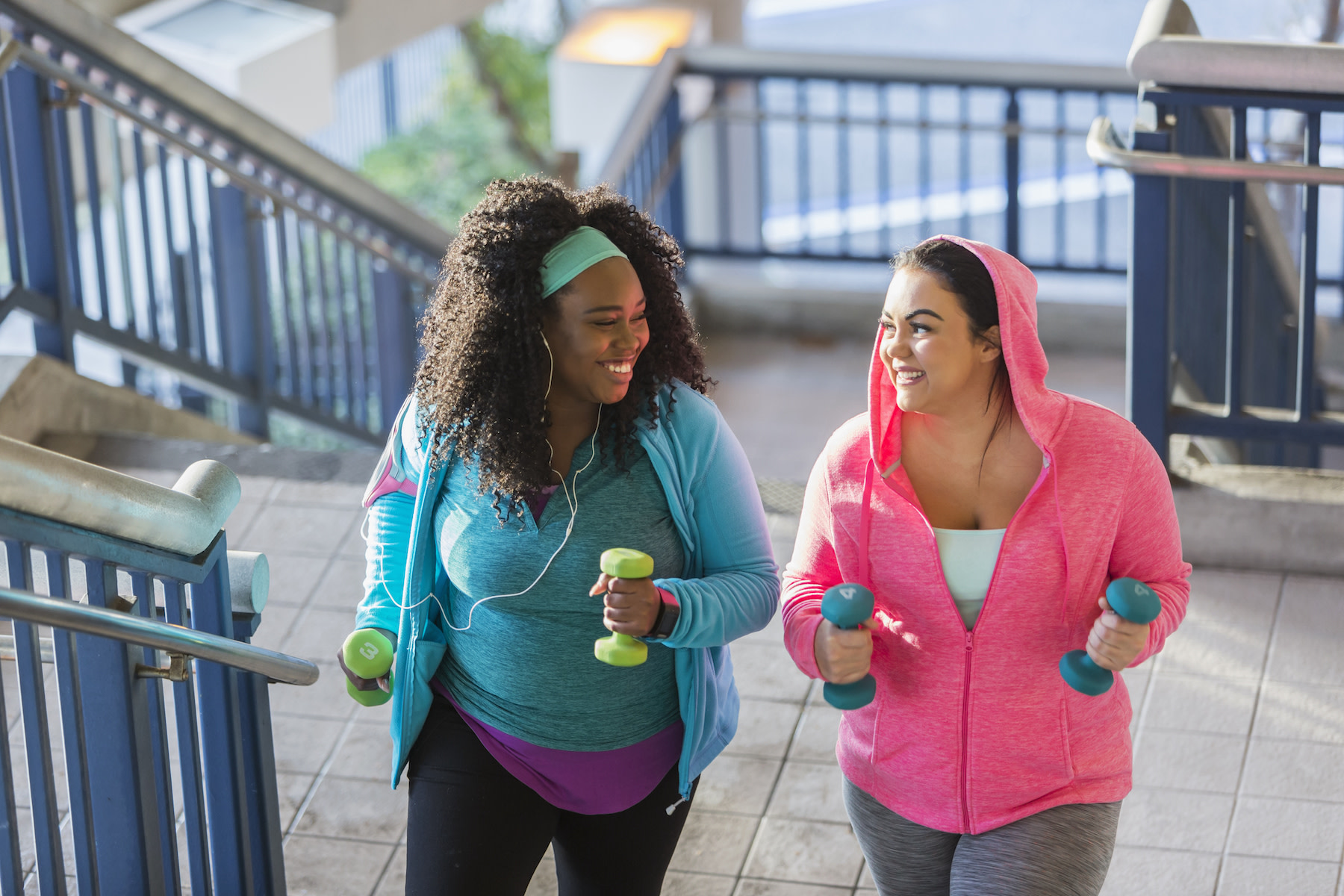
kali9 / E+ via Getty Images
How to Use Weights to Level Up Your Walking Workout
Make your walking workouts even more effective by upping the cardio effort.
By Michele Ross•
The Benefits of Walking with Weights
When to Choose A Weighted Walk Over a Normal Walk
4 Ways to Walk with Weights
Safety Considerations for Walking with Weights
How to Add Walking Weights to Your Workout Routine
Walking workouts are an effective, low-impact exercise with no shortage of physical and mental health benefits. Whether dedicated walks are already a staple in your fitness routine or you like to think of every stroll, dash to the grocery store, or walking date catching up with friends as a workout (like I do), there are always ways to challenge yourself during walks. If you want to take your walking workouts to the next level, walking with weights is a surefire way to amp up your cardio effort.
Discover more ways to reach your goals with Peloton
Keep reading to see when and why walking with weights is a good idea when you need a gentle way to challenge your body. Plus: how to safely add weighted walks into your workout routine.
The Benefits of Walking with Weights
This workout can yield the myriad benefits of walking on its own… and then some. To recap, the health and wellness perks of walking workouts include:
A lower risk of all-cause mortality, cardiovascular disease, and some cancers
Improvements in blood pressure and heart rate
Reduction of depressive symptoms and stronger emotional stability
Increased hippocampal volume and better memory
Speedier digestion after a meal
Better yet, some of these benefits can be attained by walks as brief as 5 to 20 minutes.
Once you add weights into the mix, you may be able to amplify some of the aforementioned benefits while gaining new ones. “Adding weights to your walking workouts can increase the intensity, helping to burn more calories and enhance muscle engagement,” says Peloton instructor Matty Maggiacomo. Adding resistance can potentially improve strength, he says.
There aren’t many recent studies that specifically focus on walking with hand and ankle weights. However, a handful of older studies have looked into their impact, albeit they used small sample sizes—not to mention a good few decades have passed—so it’s best to take the findings with a grain of salt. For instance, one study done in the late-80s suggest that ‘power walking’ with hand weights can deliver more oxygen to your cardiovascular system and boost your calorie burn more than standard walking, while another study from the mid-80s found that walking at 4 mph with ankle and hand weights to be as intense as running at 5 mph. Clearly, walking with weights last had it’s heyday in the 80s, and we can only hope that with newfound popularity comes more up to date research on the benefits of walking with weights.
More recent research has focused on weighted walks while wearing a weighted vest and rucking (i.e., walking with a weighted backpack). As for which one to choose if you (literally) want to go the extra mile? Both have their merits and it ultimately comes down to your personal preference. However, a small 2020 study of 9 females published in the journal Ergonomics found that those who wore a weighted vest on a treadmill showed significantly longer exercise time until volitional fatigue, compared to those who walked with a rucksack, likely due to the more even weight distribution. Published in the same journal, another 2022 study of 20 adult CrossFitters found that physiological stress increased in those wearing a weighted vest (20 pounds for men, 14 pounds for women) but only on a 10 percent gradient. In addition, the participants didn’t experience changes in stride length or frequency, which the researchers noted was a good sign in terms of injury risk.
On the other hand, rucking also demonstrates benefits including significant increases in force for exercises like jump squats, push-ups, and sit-ups (as well as a boost in estimated maximal oxygen uptake), which can be attractive for those who want to boost performance with these classic strength training moves.
When to Choose A Weighted Walk Over a Normal Walk
You might decide to take a weighted walk over a normal walk if you:
Are targeting certain gains (e.g., sculpted arms or endurance)
Know you’re not working a specific muscle group enough
Want to challenge yourself
Should You Walk with Weights Every Time You Go for a Walk?
This workout could be a fun new way to move and groove. (Moreover, you can easily integrate it into your lifestyle—even, say, by walking to the grocery store and carrying your weekly haul in a backpack to your home, or using two large bottled beverages as stand-in hand weights.) Still, you don’t need to add weights to every walk—especially on your active rest days.
“Mix up your routine by alternating between weighted and non-weighted walks,” Matty advises.
4 Ways to Walk with Weights

FG Trade Latin / E+ via Getty Images
Ankle Weights
You can strap on light ankle weights, at 1 to 3 pounds to start, no matter if you’re walking outdoors or on the treadmill. Ankle weights primarily target lower body muscles, enhancing leg strength, Matty shares. They’re good to use if you want to build strength and muscle mass in your lower body and/or you don’t normally focus on your legs during your usual workouts.
While wearing ankle weights, short walks at a leisurely pace are recommended over brisk or long walks. Harvard Health warns that overdoing things may heighten the risk of quad dominance at the expense of weakened hamstrings and otherwise pull on the ankle joint, leading to a potential tendon or ligament injury.
Avoid using ankle weights if you have any issues with your hips, knees, or ankles—as well as if you have muscle imbalances in the legs.
Hand Weights
“Handheld weights engage the upper body, contributing to a more balanced workout,” Matty explains. Just avoid using hand weights such as light dumbbells on the treadmill, as you don’t want to risk dropping them. Similar to ankle weights, he suggests beginning with 1 to 3 pounds and maxing out at 5 pounds.
When walking on firm ground with hand weights, keep your arms bent at the elbow as you power up with vertical arm movements (i.e., punching slightly forward and up) to increase the resistance your arms are working against and boost strength with each stride. All the while, be sure to keep your back straight and core engaged to maintain a stable posture.
Tip: While your arms will move naturally as you walk, you may also choose to do some bicep curls and tricep kickbacks to take things up a notch.
Weighted Vest
Intrigued about walking with weights but don’t want to carry dumbbells or strap on ankle weights? Walking with a weighted vest is one option you might want to look into.
“Weighted vests can be used for more intense training,” says Matty. They’ll essentially increase your body weight, thus making your walk more cardiovascularly and muscularly challenging. Since the extra weight is placed closer to your center of gravity, it’s a safer option for those aiming to reduce the risk of (or recovering from) strain or injury. It can also be less conspicuous than ankle weights and dumbbells, as many weighted vests are slim enough to wear under your clothes.
Plus, they may be particularly beneficial to stave off hip fractures in mature populations. Per a pilot study by the Wake Forest University School of Medicine’s INVEST program, older adults on a 12-month weight loss protocol who wore weighted vests—with weight added to the vest corresponding to their own weight loss—for 8 hours a day not only shed pounds but also slowed the progression of bone-density loss in the hips (compared to a weight-loss group that didn’t wear the vest).
Rucking
Rucking is another fun way to go for a weighted walk. Deriving from a form of military training, this workout typically entails carrying a sandbag or weights in a backpack over rugged terrains and/or long distances. (Read: This is definitely an outdoor workout.)
As Peloton instructor Logan Aldridge previously explained, beginners should start their rucking routine with:
1 to 2 rucks per week
A lighter load at 10 to 20 pounds
A relatively short distance of 1 to 3 miles
Related Articles

Beginners
How to Fit Beginner-Friendly Cardio Workouts Into Your Fitness Routine

Cardio
How to Choose Between Incline Walking and Running, Depending on Your Fitness Goals

Health
7 Reasons Why Walking After Eating Is So Beneficial

Meditation
Walking Meditations Are an Easy, Effective Way to Reduce Stress—Here's How to Get Started
Safety Considerations for Walking with Weights
Although you may be able to accept the extra weight with ease, you’ll still need to take an easy-does-it approach. As you start off your new regimen of walking with weights, heed Matty’s safety tips below:
Keep your ankle weights secure. “Make sure they are strapped on and secure at all times,” he advises. “Like your clothing, there should be absolutely no loose material that could get caught on anything.”
Keep dumbbells and other hand weights off the treadmill. “I never recommend handheld weights to be used on a treadmill, as you can risk dropping the weight and tripping on it,” Matty warns. Reserve them for outdoor walks instead.
Begin with light weights. For ankle and hand weights alike, Matty suggests starting out at 1 to 3 pounds only. You might choose to level up over time, though he suggests capping off hand weights at 5 pounds at most to avoid straining your joints.
Honor your body’s needs. Though walking with weights can be beneficial and may seem easy for many, it’s still possible to overdo it. “Listen to your body and stop if you experience pain or discomfort,” Matty advises.
Ask a pro if walking for weights is a good idea for your needs. This safety consideration is especially pertinent if you have existing health conditions or concerns, including an existing or former injury. In these cases, Matty suggests erring on the side of caution by consulting a fitness professional or physician before beginning any new fitness regimen.
How to Add Walking Weights to Your Workout Routine
As you start to walk with weights, slow and steady is the name of the game. This applies in terms of your walking pace, how much weight you use, and how often you do these weighted workouts.
Before hitting the pavement (or pressing start on your Tread), Matty suggests doing a few quick warm-up exercises, which are key for training performance and injury prevention alike. During your walk, he recommends focusing on proper posture while engaging your core muscles for added stability. “Incorporate weights gradually and maintain good form,” he reiterates.
Walking with weights is a fun and accessible way to make your cardio effort more difficult, and you can modify it to your liking with the type and heaviness of weights used. Still, it’s always a good idea to switch things up to work your body in different ways and keep your muscles guessing. Short on inspo? The Peloton App has no shortage of ways to get your blood flowing and your body moving.
This content is for informational and educational purposes only and does not constitute individualized advice. It is not intended to replace professional medical evaluation, diagnosis, or treatment. Seek the advice of your physician for questions you may have regarding your health or a medical condition. If you are having a medical emergency, call your physician or 911 immediately.
Level up your inbox.
Subscribe for a weekly dose of fitness, plus the latest promos, launches, and events.
By providing your email address, you agree to receive marketing communications from Peloton.
For more about how we use your information, see our Privacy Policy.









